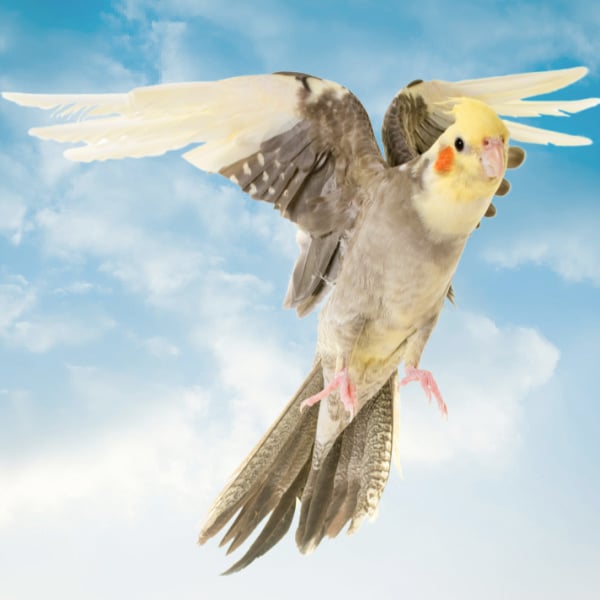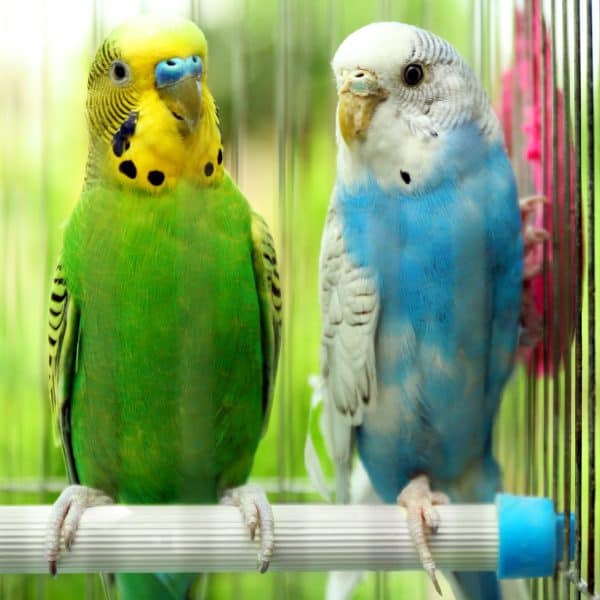Last Updated on by Mitch Rezman
The not-so-fine print: I am not an avian behaviorist. I have no formal training in veterinary medicine. My expertise is in helping you create the best environment that you can for your bird.
Sounds simple, but we have to figure out how to squeeze 35 square miles of forging opportunities your bird would normally have in the wild, into typically a few hundred square feet of your home which funnels down to, if they’re lucky, 8 to 10 square feet of bird jail up to 12 hours or even more a day.
We do that part well. Ask us – will give you a bunch of ideas. Some will require buying bird supplies. Most other ideas can be done much like a craft project and who doesn’t like a craft project?.
The ideas that I talk about here come from our everyday experiences with all of you and the relationship that we have with our cockatiel Popcorn.
Popcorn convalescing with mom
To those not familiar with my relationship with Popcorn. She’s a White Faced Lutino Cockatiel that we literally rescued after having been trapped in some bushes about two blocks from the Birdie Boutique. We’ve had her for about 18 months and she is one great bird. She loves Catherine and me equally. BUT…I leave later in the morning and so Popcorn gets up with me and helps me with my morning chores. Bed making, teeth brushing, tidying – she’s VERY helpful.
If she’s not on a shoulder or my head she’s on any number of landing zones we’ve designated throughout the house. Sometimes she anticipates my moves and meets me, especially the bathroom. She doesn’t like to bathe in the shower, she likes to bathe in the bathroom sink.
She does like to sit on the shower curtain rod and clearly enjoys the warm steam coming out of the shower. I splash her with water and she fidgets but she doesn’t fly away. The rod is 7 feet off the ground. This morning she was on the floor of the bathroom which was unusual.
If she’s that low I grab her lightly from the top, lift her off the ground about a foot and let her drop. She never comes close to the floor and always just takes off sometimes almost vertically and happily jumps on the shower curtain rod.
The shower curtain rod has a “poop towel” hung over it. This morning when I picked her up from the bathroom floor then released her, she took off but flew onto the poop towel and crawled her way to the top. She clearly couldn’t gain altitude.
I had her step up on my hand we went over to her cage and I stepped back 3 feet, lifted her with my left hand placed on the palm of my right hand, and made a slight upward motion as to “go fly”.
She couldn’t make it to the top of the cage and landed on the side and crawled up. She was sick. There’s your answer to the title of this post. I’ve tried to be very even handed in talking about both the flighted and clipped wing camps. But this is another big win for the flighted camp as far as I’m concerned. Without that simple queue of lost altitude, Popcorn might have not seen Dr. Byron de la Navarre for several more days until we saw other symptoms – think about it.
Now for a very interesting Segway. We’ve known Dr. Byron and his wife Tracy for more than a dozen years. They run Animal House of Chicago and handle conventional pets as well as exotics. Dr. Byron is a board-certified avian vet and has been our personal veterinarian for the entire time we’ve known him.
During intake we talked about how she had recently come out of a molt, she was exhibiting brooding properties looking for nest building opportunities and was masturbating a lot (using her Booda Comfy Perches).
First digression: We are now rearranging the Booda soft rope perches regularly to reduce brooding stimulation. She also has a foraging box in the bottom of her cage that we refill immediately after she empties it so she doesn’t have the opportunity to get in it. (it is very small, only 5 x 3 x 2 with an open top).
Second digression: In that Popcorn is a White Faced Lutino Cockatiel – she’s a mutation. Dr. Byron spoke about his 15 years at Niles Animal Hospital years ago, that once they started seeing the pied’s and the pearls, those mutations were more prone to illness and shorter lives than the standard gray Australian cockatiel
After blood, fecal testing and a physical exam, her bacterial infection was back from earlier this year and her white blood cell count was high meaning the resistance was low.
This is what we talk about when looking at your birds holistically. A brooding bird (her cervix was spread as well) causes calories to be used for the breeding process which takes away those calories from normal functions.
Add to that a molting bird’s body is using more calories to regrow the recently lost feathers which takes even more calories away from everyday physical needs. To further place stress on the bird immune system, antibodies are careful to stay away from the reproductive area of the bird so they don’t kill things like male sperm
Throwing even more stress on the heap, our birds are dealing with the constant change in light cycles with daylight savings time. All of this combined – light cycles, molting, brooding all just beat the crap out of these amazing feathered creatures. By the way, she was almost a hundred 130 g when normally she’s about 120 g meaning she was retaining water.
Key takeaway in this week’s episode of “Life with Popcorn the White Cockatiel”.
General consensus about using vitamin supplements has been to provide supplements for birds on a seed diet. Pelleted food is engineered to be a fully nutritional product for your caged bird with vitamins.
So now we’re going to advocate that if your bird is molting and or broody thinks about introducing an all-purpose avian vitamin-like Nekton S Multi-vitamin Supplement For Cage Birds.
Caveat: we a lot of people who come into the Birdie Boutique shopping for the new bird and inevitably they asked for or put cuttlebone in their shopping cart. We always asked why and get the same answer “Because I thought it was good for my bird”.
Well, it is if your bird is producing eggs that are depleting the calcium. If your bird is not producing eggs or in a brooding mode physiologically, let nature take care of its calcium levels.
Please share your thoughts about this week’s observations, below.
Written by Mitch Rezman
Approved by Catherine Tobsing.
Author Profile
Latest entries
 The Traveling BirdJune 26, 2025Can You Name 5 Parrot Species That Are Living Wild in the USA?
The Traveling BirdJune 26, 2025Can You Name 5 Parrot Species That Are Living Wild in the USA? Bird BehaviorJune 26, 2025How is it Parrots Are Problem Solvers Social Animals and Even Use Tools?
Bird BehaviorJune 26, 2025How is it Parrots Are Problem Solvers Social Animals and Even Use Tools? Bird & Parrot AnatomyJune 25, 2025How a Tiny Chemical Modification Makes Parrots Nature’s Living Paintings
Bird & Parrot AnatomyJune 25, 2025How a Tiny Chemical Modification Makes Parrots Nature’s Living Paintings PigeonsJune 20, 2025How Do Parrots Thrive in Cities Outside Their Native Habitats?
PigeonsJune 20, 2025How Do Parrots Thrive in Cities Outside Their Native Habitats?





devilish dori
7 Sep 2016hi there..my love bird stopped flying about a year ago. She tries but she just does face plants…and when she sitting on the countertop, it seems that her head is too heavy. She does face plants even when standing??? Helpppp
WindyCityParrot
7 Sep 2016Hi dori
I would advocate a trip to the vet – it appears as though your bird is ill
mitchr
WindyCityParrot
7 Oct 2016Before we can answer this dori we need to her what your avian vet has to say